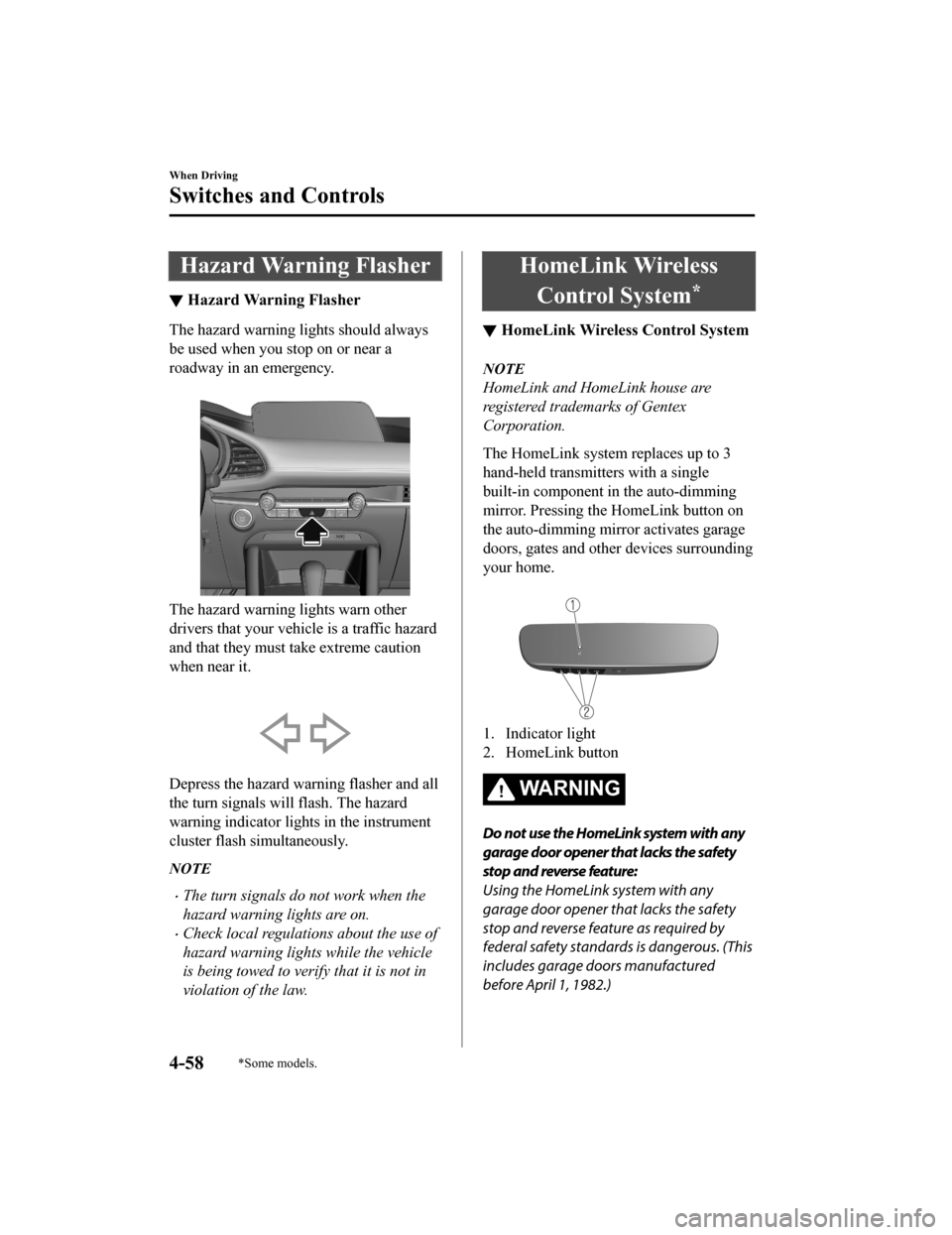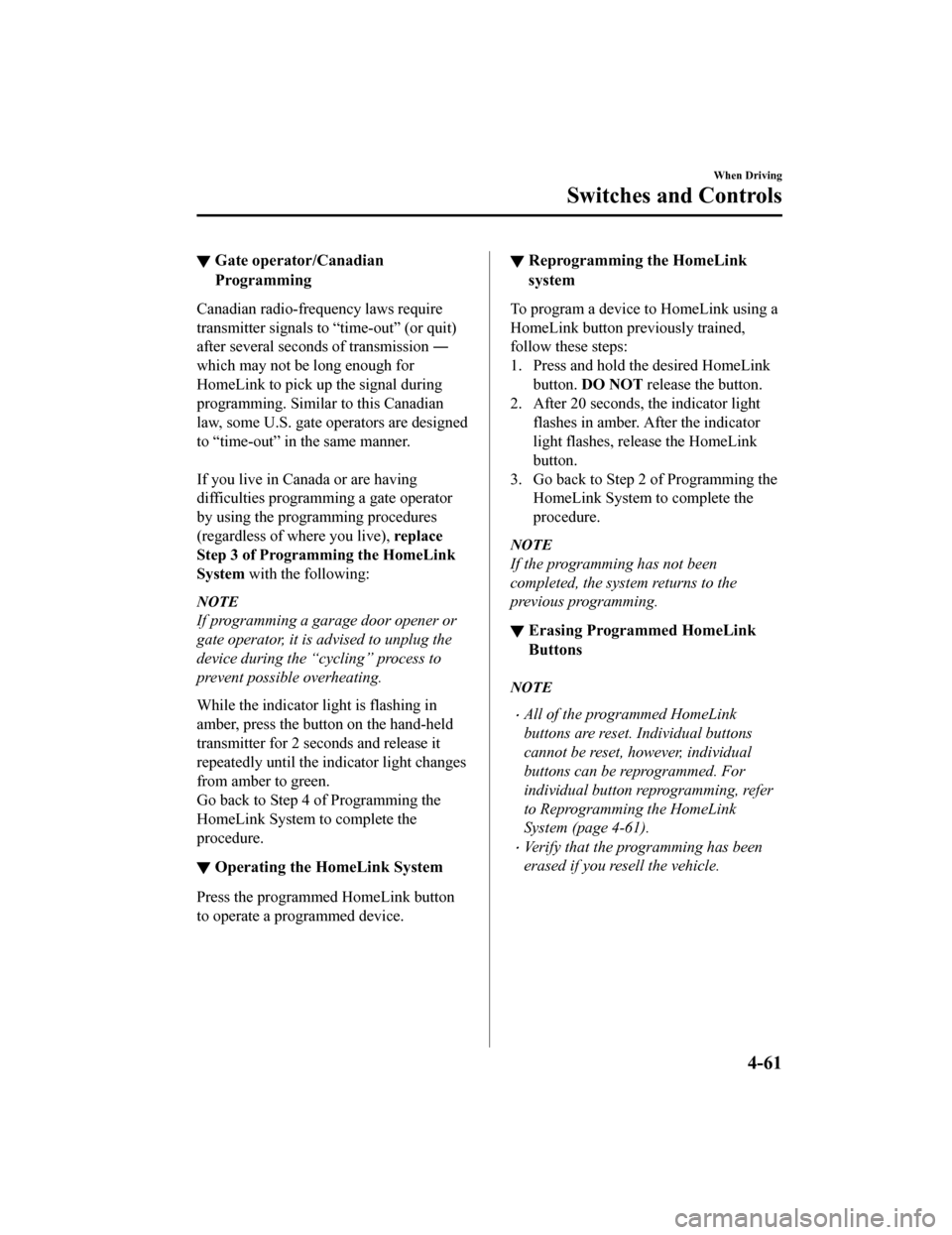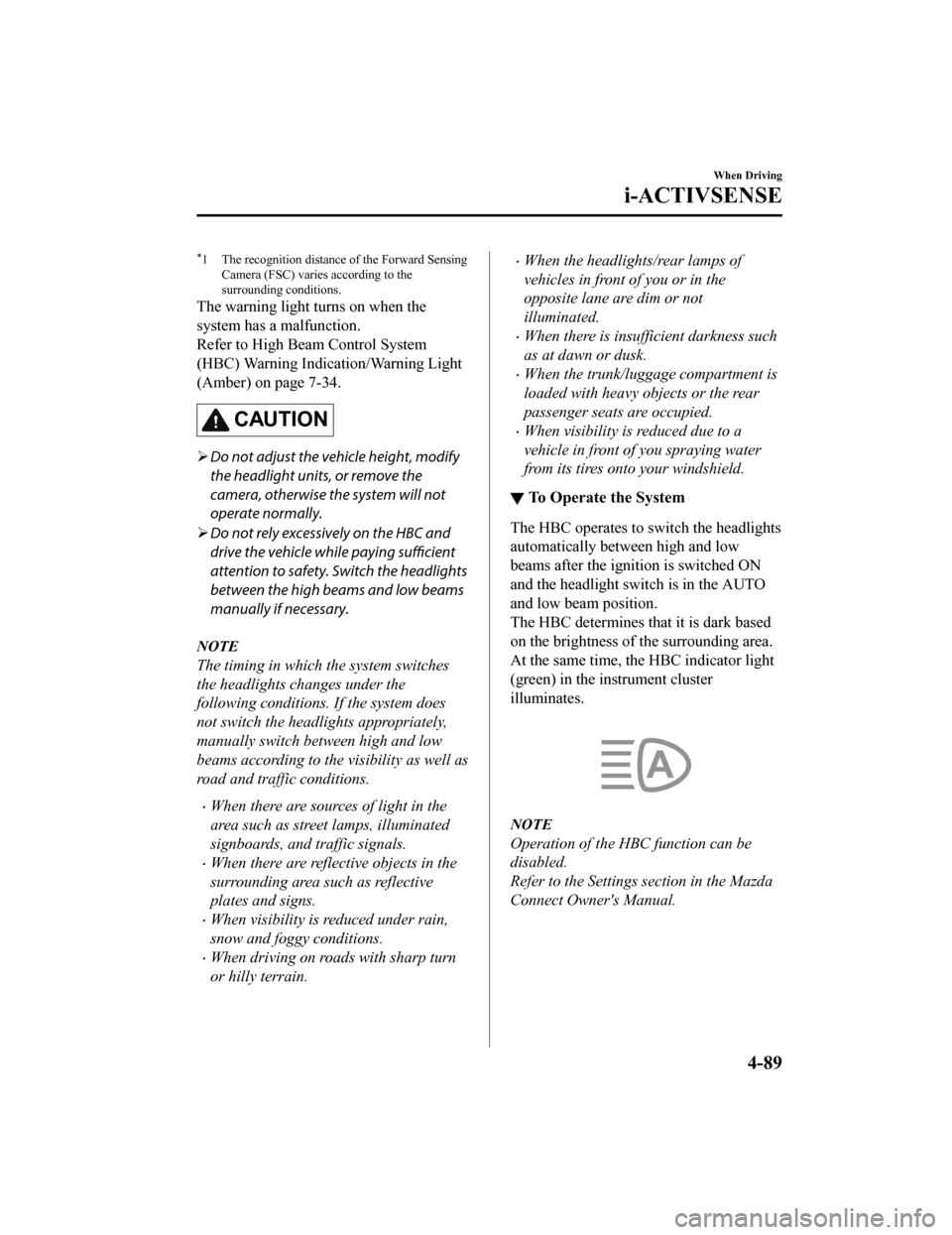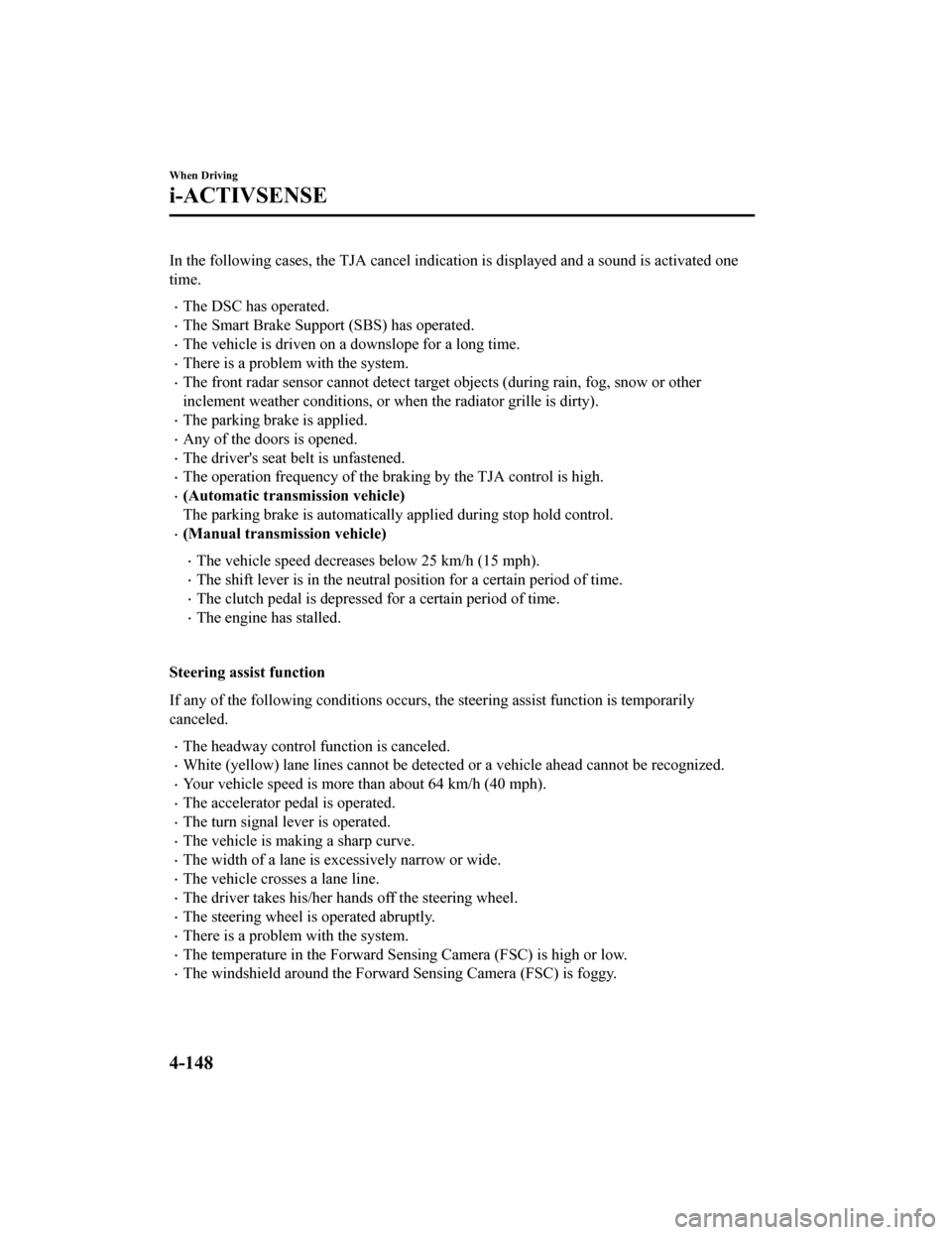turn signal MAZDA MODEL 3 HATCHBACK 2020 (in English) User Guide
[x] Cancel search | Manufacturer: MAZDA, Model Year: 2020, Model line: MODEL 3 HATCHBACK, Model: MAZDA MODEL 3 HATCHBACK 2020Pages: 598, PDF Size: 89.37 MB
Page 192 of 598

▼Coming Home Light
The coming home light turns on the
headlights (low beam
s) when the lever is
operated.
To turn on the lights
When the lever is pulled with the ignition
switched to ACC or OFF, the low beam
headlights turn on.
The headlights turn off after a certain
period of time has elapsed after all of the
doors are closed.
NOTE
The time until the he adlights turn off
after all of the doors are closed can be
changed.
Refer to the Settings section in the
Mazda Connect Owner's Manual.
If no operations are done for 3 minutes
after the lever is pulled, the headlights
turn off.
The headlights turn off if the lever is
pulled again while the headlights are
illuminated.
▼ Leaving Home Light
The leaving home light turns on the lights
when the transmitte
r unlock button is
pressed while away from the vehicle.
The following light s turn on when the
leaving home light is operated.
Low beams, Parking lights, Taillights,
License plate lights.
To turn on the lights
When the ignition switch and the headlight
switch are in the following conditions, the
headlights will ill uminate when the
transmitter unlock button is pressed and
the vehicle receives the transmitter signal.
The headlights turn o ff after a certain
period of time has elapsed (30 seconds).
Ignition switch: off
Headlight switch: AUTO, , or
1. Lock button
2. Unlock button
NOTE
Operation of the leaving home light can
be turned on or off.
Refer to the Settings section in the
Mazda Connect Owner's Manual.
When the transmitter lock button is
pressed and the vehicle receives the
transmitter signal, the headlights turn
off.
When the headlight switch is turned to
the OFF position, the headlights turn
off.
When Driving
Switches and Controls
4-48
Mazda3_8HZ1-EA-19G_Edition1_old 2019-5-17 13:49:03
Page 194 of 598

Turn and Lane-ChangeSignals
▼Turn and Lane-Change Signals
The ignition must be switched ON to use
the turn and lane
-change signals.
▼Turn Signals
Move the signal lever down (for a left
turn) or up (for a righ
t turn) to the stop
position. The signal will self-cancel after
the turn is completed.
If the indicator light continues to flash
after a turn, manually return the lever to its
original position.
1. Right turn
2. Right lane change
3. OFF
4. Left lane change
5. Left turn
The turn signal indicators in the
instrument cluster flash according to the
operation of the turn signal lever to show
which signal is working.
NOTE
There may be a problem with the turn
signal lights if they do not flash but
remain turned on, or they flash
abnormally. Have your vehicle inspected
by an Authorized Mazda Dealer.
A personalized function is available to
change the turn indicator sound volume.
Refer to the Settings section in the
Mazda Connect Owner's Manual.
▼ Lane-Change Signals
Move the lever halfway toward the
direction of the lane change―until the
indicator flashes― and hold it there. It
will return to the off position when
released.
▼Three-Flash Turn Signal
After releasing the turn signal lever from
the halfway point, the turn signal indicator
flashes 3 times. The
operation can be
cancelled by moving the lever in the
direction opposite to which it was
operated.
NOTE
The three-flash turn signal function can be
switched to on/off using the
personalization function.
Refer to the Settings section in the Mazda
Connect Owner's Manual.
When Driving
Switches and Controls
4-50
Mazda3_8HZ1-EA-19G_Edition1_old 2019-5-17 13:49:03
Page 202 of 598

Hazard Warning Flasher
▼Hazard Warning Flasher
The hazard warning lights should always
be used when you stop on or near a
roadway in an emergency.
The hazard warning lights warn other
drivers that your vehicle is a traffic hazard
and that they must take extreme caution
when near it.
Depress the hazard warning flasher and all
the turn signals wi
ll flash. The hazard
warning indicator lights in the instrument
cluster flash simultaneously.
NOTE
The turn signals do not work when the
hazard warning lights are on.
Check local regulations about the use of
hazard warning lights while the vehicle
is being towed to verify that it is not in
violation of the law.
HomeLink Wireless
Control System
*
▼ HomeLink Wireless Control System
NOTE
HomeLink and HomeLink house are
registered trademarks of Gentex
Corporation.
The HomeLink system replaces up to 3
hand-held transmitters with a single
built-in component in the auto-dimming
mirror. Pressing the HomeLink button on
the auto-dimming mirror activates garage
doors, gates and other devices surrounding
your home.
1. Indicator light
2. HomeLink button
WA R N I N G
Do not use the HomeLink system with any
garage door opener that lacks the safety
stop and reverse feature:
Using the HomeLink system with any
garage door opener that lacks the safety
stop and reverse feature as required by
federal safety standards is dangerous. (This
includes garage doors manufactured
before April 1, 1982.)
When Driving
Switches and Controls
4-58*Some models.
Mazda3_8HZ1-EA-19G_Edition1_old
2019-5-17 13:49:03
Page 205 of 598

▼Gate operator/Canadian
Programming
Canadian radio-frequency laws require
transmitter signals to “time-out” (or quit)
after several seconds of transmission ―
which may not be long enough for
HomeLink to pick up the signal during
programming. Simila
r to this Canadian
law, some U.S. gate ope rators are designed
to “time-out” in the same manner.
If you live in Canad a or are having
difficulties progra mming a gate operator
by using the programming procedures
(regardless of where you live), replace
Step 3 of Programming the HomeLink
System with the following:
NOTE
If programming a garage door opener or
gate operator, it is advised to unplug the
device during the “cycling” process to
prevent possible overheating.
While the indicator light is flashing in
amber, press the button on the hand-held
transmitter for 2 seconds and release it
repeatedly until the indicator light changes
from amber to green.
Go back to Step 4 of Programming the
HomeLink System to complete the
procedure.
▼Operating the HomeLink System
Press the programmed HomeLink button
to operate a programmed device.
▼Reprogramming the HomeLink
system
To program a device to HomeLink using a
HomeLink button previously trained,
follow these steps:
1. Press and hold the desired HomeLink
button. DO NOT release the button.
2. After 20 seconds, the indicator light flashes in amber. A fter the indicator
light flashes, release the HomeLink
button.
3. Go back to Step 2 of Programming the HomeLink System to complete the
procedure.
NOTE
If the programming has not been
completed, the system returns to the
previous programming.
▼Erasing Programmed HomeLink
Buttons
NOTE
All of the programmed HomeLink
buttons are reset. Individual buttons
cannot be reset, however, individual
buttons can be reprogrammed. For
individual button reprogramming, refer
to Reprogramming the HomeLink
System (page 4-61).
Verify that the programming has been
erased if you resell the vehicle.
When Driving
Switches and Controls
4-61
Mazda3_8HZ1-EA-19G_Edition1_old
2019-5-17 13:49:03
Page 233 of 598

*1 The recognition distance of the Forward SensingCamera (FSC) varies according to the
surrounding conditions.
The warning light turns on when the
system has a malfunction.
Refer to High Beam Control System
(HBC) Warning Indication/Warning Light
(Amber) on page 7-34.
CAUTION
Do not adjust the ve hicle height, modify
the headlight units, or remove the
camera, otherwise the system will not
operate normally.
Do not rely excessively on the HBC and
drive the vehicle while paying sufficient
attention to safety. Switch the headlights
between the high beams and low beams
manually if necessary.
NOTE
The timing in which the system switches
the headlights changes under the
following conditions. If the system does
not switch the headlights appropriately,
manually switch between high and low
beams according to the visibility as well as
road and traffic conditions.
When there are sources of light in the
area such as street lamps, illuminated
signboards, and traffic signals.
When there are reflective objects in the
surrounding area such as reflective
plates and signs.
When visibility is reduced under rain,
snow and foggy conditions.
When driving on roads with sharp turn
or hilly terrain.
When the headlights/rear lamps of
vehicles in front of you or in the
opposite lane are dim or not
illuminated.
When there is insufficient darkness such
as at dawn or dusk.
When the trunk/luggage compartment is
loaded with heavy objects or the rear
passenger seats are occupied.
When visibility is reduced due to a
vehicle in front of you spraying water
from its tires onto your windshield.
▼ To Operate the System
The HBC operates to switch the headlights
automatically between high and low
beams after the ignition is switched ON
and the headlight switch is in the AUTO
and low beam position.
The HBC determines t
hat it is dark based
on the brightness of the surrounding area.
At the same time, th e HBC indicator light
(green) in the instrument cluster
illuminates.
NOTE
Operation of the HBC function can be
disabled.
Refer to the Settings section in the Mazda
Connect Owner's Manual.
When Driving
i-ACTIVSENSE
4-89
Mazda3_8HZ1-EA-19G_Edition1_old 2019-5-17 13:49:03
Page 236 of 598

▼When the System Operates
When the ignition is switched ON, the
i-ACTIVSENSE status symbol (warning/
risk avoidance support system) (white)
turns on and the system goes on standby.
NOTE
If the i-ACTIVSENSE status symbol
(warning/risk avoidance support system)
(white) does not turn on, the system is
canceled using the i-ACTIVSENSE switch
or the personalization feature.
Operation conditions
When all of the foll
owing conditions are
met, the i-ACTIVSE NSE status symbol
(warning/risk avoidance support system)
on the multi-information display changes
from white to green and the system
becomes operational.
The ignition i s switched ON.
The vehicle speed is about 64 km/h (40
mph) or faster.
The system detects white (yellow) lane
lines.
NOTE
When the system does not detect a white
(yellow) lane line on one side only, the
system does not operate on the side that is
not being detected.
When temporarily canceling the system
The LDWS goes on standby in the
following cases: The LDWS operation is
automatically restored when the system's
operation conditions are met.
The system cannot detect white (yellow)
lane lines.
The vehicle speed is less than about 56
km/h (35 mph).
The turn signal lever is operated.
The accelerator pedal is depressed.
The steering wheel is operated.
The brake pedal is operated.
The function is temporarily stopped.
The LDWS stops functioning in the
following cases:
The temperature in the forward sensing
camera (FSC) is high or low.
The windshield around the forward
sensing camera (FSC) is foggy.
The windshield around the forward
sensing camera (FSC) is blocked by an
obstruction, causing poor forward
visibility.
When Driving
i-ACTIVSENSE
4-92
Mazda3_8HZ1-EA-19G_Edition1_old 2019-5-17 13:49:03
Page 238 of 598

Blind Spot Monitoring(BSM)
*
▼Blind Spot Monitoring (BSM)
The BSM is designed to assist the driver in
checking the area to the rear of the vehicle
on both sides during lane changes by
notifying the driver of the presence of
vehicles approaching from the rear in an
adjacent lane.
BSM operation
The BSM detects vehicles approaching
from the rear while traveling in the
forward direction at a speed of 10 km/h
(6.3 mph) or faster and notifies the driver
by turning on the BSM warning indicator
light and displaying t
he vehicle detection
screen.
If the turn signal lever is operated to signal
a turn in the direc tion in which the BSM
warning indicator light is illuminated
while the approaching vehicle is detected,
the BSM notifies the driver of possible
danger flashing on the BSM warning
indicator light, and by activating the
warning sound and the warning screen
indicator display.
The detection area on this system covers
the driving lanes on both sides of the
vehicle and from the rear part of the front
doors to about 50 m (164 ft) behind the
vehicle.
1. Your vehicle
2. Detection areas
WA R N I N G
Always check the surrounding area visually
before making an actual lane change:
The system is only designed to assist you in
checking for vehicles at your rear when
making a lane change. Due to certain
limitations with the operation of this
system, the BSM warning indicator light,
the warning sound and the warning screen
indicator display may not activate or they
might be delayed even though a vehicle is
in an adjacent driving lane. Always make it
your responsibility as a driver to check the
rear.
NOTE
The BSM will operate when all of the
following conditions are met:
The ignition is switched ON.
The i-ACTIVSENSE warning
indication/warning light in the
instrument cluster is turned off.
When Driving
i-ACTIVSENSE
4-94*Some models.
Mazda3_8HZ1-EA-19G_Edition1_old 2019-5-17 13:49:03
Page 242 of 598

Active Driving Display (vehicles with
active driving display)
The detected direction is displayed with a
detection indicator (white) when an
approaching vehicle is detected. In
addition, if the turn signal lever is operated
to signal a lane change while the vehicle is
detected, the display changes the color
(amber) of the warning indicator.
BSM warning beep
The BSM warning beep is activated
simultaneously with the flashing of a BSM
warning indicator light.
▼ Canceling Operation of Blind Spot
Monitoring (BSM)
The BSM system can be set to inoperable.
(If only the BSM is turned off)
Refer to the Settings section in the
Mazda Connect Owner's Manual.
(If the BSM is turne
d off by operating
the i-ACTIVSENSE switch)
Refer to i-ACTIVSENSE Switch on
page 4-87.
NOTE
If the ignition is switched OFF while you
have canceled the system using the
i-ACTIVSENSE swit ch, the system is
automatically enabled the next time the
ignition is switched ON. However, if the
system is canceled using the
personalization features, the system is not
automatically enabled.
When Driving
i-ACTIVSENSE
4-98
Mazda3_8HZ1-EA-19G_Edition1_old 2019-5-17 13:49:03
Page 288 of 598

Steering assist function
The steering assist function operates when all of the following conditions are met.
Your vehicle is moving and less than about 56 km/h (35 mph).
White (yellow) lane lines on both sides are detected and you ar e driving near the center of
the lane, or your vehicle detects a vehicle ahead.
The steering wheel is not turned sharply.
The turn signal lever is not operated.
The headway control function is operating.
(Manual transmission vehicle)
The vehicle speed is about 30 km/h (19 mph) or faster.
NOTE
The steering assist function operates so that the vehicle remains near the center of the
driving lane, however, depending on conditions such as the road curvature, road slope and
undulations, and vehicle speed, th e function might not be able to keep the vehicle near the
center of the driving lane.
Setting method
1. CANCEL switch
2. RES switch
3. TJA switch
1. Press the TJA switch. The TJA standby indication (white) turns on. In addition, the T JA display indication is
displayed on the mu lti-information display at the same time.
When Driving
i-ACTIVSENSE
4-144
Mazda3_8HZ1-EA-19G_Edition1_old 2019-5-17 13:49:03
Page 292 of 598

In the following cases, the TJA cancel indication is displayed and a sound is activated one
time.
The DSC has operated.
The Smart Brake Support (SBS) has operated.
The vehicle is driven on a downslope for a long time.
There is a problem with the system.
The front radar sensor cannot detect target objects (during rai n, fog, snow or other
inclement weather conditions, or when the radiator grille is dirty).
The parking brake is applied.
Any of the doors is opened.
The driver's seat belt is unfastened.
The operation frequency of the braking by the TJA control is hi gh.
(Automatic transmission vehicle)
The parking brake is automatical ly applied during stop hold control.
(Manual transmission vehicle)
The vehicle speed decreases below 25 km/h (15 mph).
The shift lever is in the neutral position for a certain period of time.
The clutch pedal is depressed for a certain period of time.
The engine has stalled.
Steering assist function
If any of the fo llowing conditions occurs, the steering assist function is temporarily
canceled.
The headway control function is canceled.
White (yellow) lane lines cannot be detected or a vehicle ahead cannot be recognized.
Your vehicle speed is more than about 64 km/h (40 mph).
The accelerator pedal is operated.
The turn signal lever is operated.
The vehicle is making a sharp curve.
The width of a lane is excessively narrow or wide.
The vehicle crosses a lane line.
The driver takes his/her hands off the steering wheel.
The steering wheel is operated abruptly.
There is a problem with the system.
The temperature in the Forward Sensing Camera (FSC) is high or low.
The windshield around the Forward Sensing Camera (FSC) is foggy .
When Driving
i-ACTIVSENSE
4-148
Mazda3_8HZ1-EA-19G_Edition1_old 2019-5-17 13:49:03